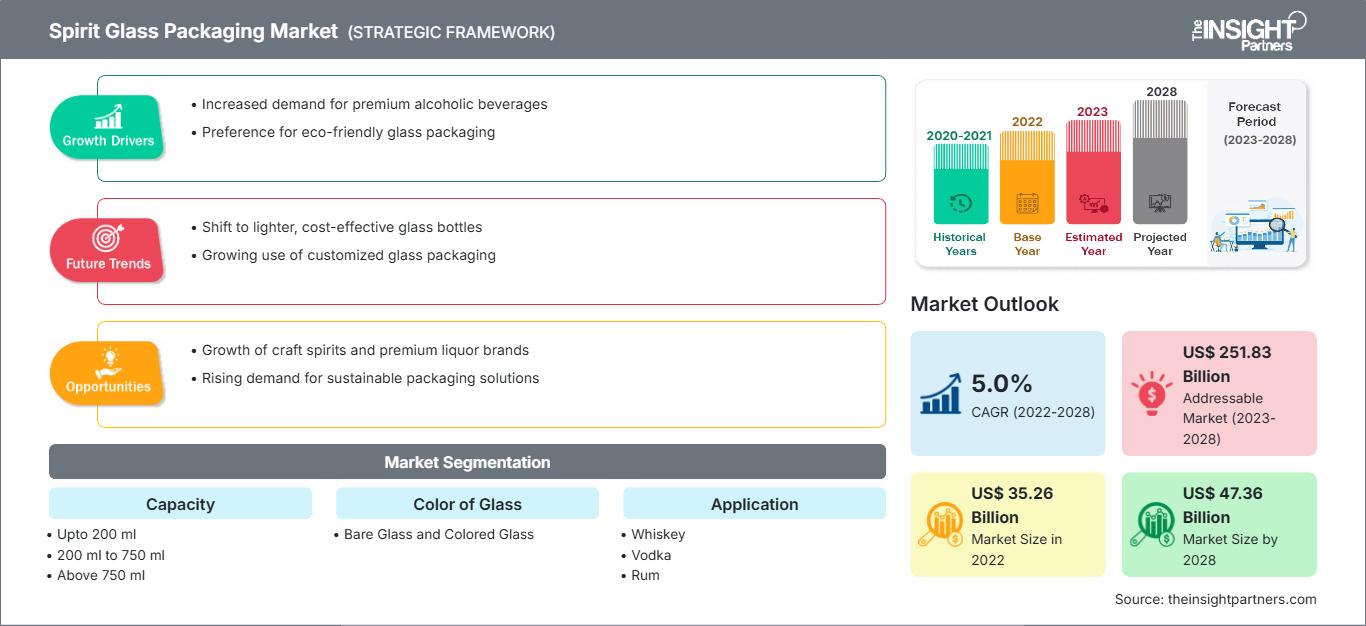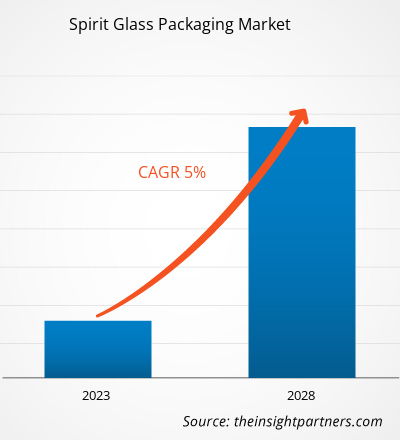[Rapporto di ricerca]Il mercato degli imballaggi in vetro per alcolici è stato valutato a 35.258,06 milioni di dollari nel 2022 e si prevede che raggiungerà i 47.357,29 milioni di dollari entro il 2028; si stima che registrerà un CAGR del 5,0% dal 2022 al 2028.
Gli imballaggi in vetro per alcolici sono ampiamente utilizzati nel settore degli alcolici per contenere prodotti alcolici come vino, birra, rum, whisky e vodka, tra gli altri. L'innovazione di prodotto di diversi alcolici, come i liquori aromatizzati e lo sviluppo di miscele di alcolici in bottiglia, creano una domanda di imballaggi in vetro per alcolici. Gli imballaggi in vetro dal design distintivo e dai colori variegati migliorano l'esperienza sensoriale complessiva e influenzano la decisione di acquisto dei consumatori. Il design e la tipologia degli imballaggi in vetro influenzano positivamente l'immagine del marchio, la differenziazione del prodotto, l'accettabilità e la preferenza del prodotto. La crescente preferenza dei consumatori per gli imballaggi in vetro ha spinto i produttori di alcolici a offrire una differenziazione dei prodotti attraverso il design del packaging e prodotti innovativi. Ciò è dovuto alla disponibilità di bottiglie in vetro con fondo spesso, goffrature e decorazioni, abbinate al design dell'etichetta; tutte queste caratteristiche forniscono un'immagine di marca armoniosa e di alta qualità e trasmettono la storia del marchio o del prodotto.
Nel 2022, l'Asia-Pacifico ha detenuto la maggiore quota di mercato globale degli imballaggi in vetro per alcolici. La crescita del mercato in Giappone, India, Cina, Australia, Corea del Sud, Singapore, Taiwan e Indonesia è attribuita al crescente consumo di alcol tra la popolazione; al cambiamento delle preferenze da birre standard a birre premium, whisky, vodka, vini e altri alcolici; a un numero crescente di celebrazioni con bevande alcoliche; e a innovazioni di prodotto insolite da parte dei produttori di alcolici in tutta la regione. Ad esempio, nel settembre 2020, la Scrapegrace Distillery, una distilleria con sede in Nuova Zelanda, ha prodotto il primo gin nero naturale al mondo (natural black brew), ottenuto da una miscela di botaniche insolite. Inoltre, questo gin premium assume tonalità rosse e viola se miscelato con acqua tonica. La distilleria ha venduto una fornitura di prodotto sufficiente per tre mesi in 24 ore. Con l'aumento delle vendite, anche la domanda di imballaggi in vetro è cresciuta in modo significativo. Tutti questi fattori contribuiscono alla crescita del mercato regionale degli imballaggi in vetro per alcolici.
Personalizza questo rapporto in base alle tue esigenze
Potrai personalizzare gratuitamente qualsiasi rapporto, comprese parti di questo rapporto, o analisi a livello di paese, pacchetto dati Excel, oltre a usufruire di grandi offerte e sconti per start-up e università
Mercato degli imballaggi in vetro per alcolici: Approfondimenti strategici

- Ottieni le principali tendenze chiave del mercato di questo rapporto.Questo campione GRATUITO includerà l'analisi dei dati, che vanno dalle tendenze di mercato alle stime e alle previsioni.
Potrai personalizzare gratuitamente qualsiasi rapporto, comprese parti di questo rapporto, o analisi a livello di paese, pacchetto dati Excel, oltre a usufruire di grandi offerte e sconti per start-up e università
Mercato degli imballaggi in vetro per alcolici: Approfondimenti strategici

- Ottieni le principali tendenze chiave del mercato di questo rapporto.Questo campione GRATUITO includerà l'analisi dei dati, che vanno dalle tendenze di mercato alle stime e alle previsioni.
Impatto della pandemia di COVID-19 sul mercato del packaging in vetro per alcolici
La pandemia di COVID-19 ha avuto un impatto significativo sul mercato del packaging in vetro per alcolici. I lockdown globali e le restrizioni su viaggi e assembramenti sociali hanno portato a un calo del consumo di bevande alcoliche, con conseguente calo della domanda di packaging in vetro per alcolici. Molti bar, ristoranti e hotel, importanti clienti del settore HORECA, sono stati costretti a chiudere temporaneamente o a operare a capacità ridotta, con conseguente riduzione della domanda di bottiglie di vetro di piccole dimensioni. Inoltre, l'interruzione della catena di approvvigionamento dovuta alle restrizioni sui trasporti e sulle attività di produzione ha aumentato i costi di produzione e distribuzione del packaging in vetro per alcolici.
Nel 2021, il mercato globale ha iniziato a riprendersi dalle perdite subite nel 2020, con l'annuncio da parte dei governi di diversi paesi di un allentamento delle restrizioni sociali. Ai produttori è stato consentito di operare a piena capacità, il che li ha aiutati a colmare il divario tra domanda e offerta. Inoltre, l'aumento dei tassi di vaccinazione ha contribuito a migliorare le condizioni generali in diversi paesi, creando ambienti favorevoli al progresso industriale e commerciale. L'aumento della capacità produttiva di alcolici in Asia-Pacifico e in Europa ha ulteriormente aumentato la domanda di imballaggi in vetro per alcolici nel 2021.
Approfondimenti di mercato
Crescita del settore HORECA
Il settore HORECA è uno dei principali utilizzatori finali di imballaggi in vetro per alcolici. L'HORECA è chiamato Hotel/Restaurant/Catering, una parte del segmento della ristorazione che comprende bar, pub, birrerie, club e hotel, tra gli altri. L'impatto dell'HORECA sul packaging in vetro per alcolici è significativo a causa dell'elevato volume di prodotti consumati dal settore. La propensione della popolazione globale verso cibi e bevande da asporto e l'aumento del reddito disponibile stanno dando impulso al settore HORECA in tutto il mondo. Secondo la National Restaurant Association (USA), il settore alimentare e catering Le vendite di bevande del segmento full-service (che comprende ristoranti per famiglie, ristoranti informali e ristoranti raffinati) sono cresciute da 199 miliardi di dollari nel 2020 a 289 miliardi di dollari nel 2022. Al contrario, le vendite statunitensi del segmento a servizio limitato (che comprende ristoranti quick-service, ristoranti fast-casual e mense) sono aumentate da 297 miliardi di dollari nel 2020 a 355 miliardi di dollari nel 2022. Il rapporto ha rivelato che le vendite di cibo e bevande Le bevande negli Stati Uniti provenienti da bar, taverne, locali notturni o luoghi dedicati alla preparazione e alla somministrazione di bevande alcoliche sono cresciute da 13 miliardi di dollari nel 2020 a 21 miliardi di dollari nel 2022.
Informazioni sulla capacità
In base alla capacità, il mercato globale degli imballaggi in vetro per alcolici è segmentato in fino a 200 ml, da 200 ml a 750 ml e oltre 750 ml. Il segmento da 200 ml a 750 ml ha detenuto la quota di mercato globale più significativa degli imballaggi in vetro per alcolici nel 2022. Questa categoria include bottiglie di vetro con capacità come 375 ml, 500 ml, 650 ml, 700 ml e 750 ml. Questi tipi di bottiglie di vetro sono disponibili in varie forme e design. Inoltre, questi tipi di bottiglie di vetro sono disponibili in diversi colori, come marrone ambra, bianco flint, smeraldo, verde, blu zaffiro, giallo sole, nero lingotto e canna di fucile metallizzato. Queste bottiglie di vetro sono utilizzate principalmente per il confezionamento di brandy, gin, rum, tequila, vodka, whisky, vino, birra, ecc. Le bottiglie da 375 ml e 650 ml sono utilizzate principalmente per il confezionamento di birra, mentre quelle da 750 ml sono utilizzate principalmente per liquori come whisky, gin, rum, tequila e liquori. Inoltre, i produttori di vetro per alcolici si concentrano sulla realizzazione di bottiglie di vetro accattivanti di varie capacità, che influenzeranno i prezzi dei prodotti e il comportamento d'acquisto dei consumatori.
I principali attori che operano nel mercato globale del packaging in vetro per alcolici includono OI Glass Inc, Toyo Glass Co Ltd, Ardagh Group SA, Verallia SA, Vidrala SA, Gerresheimer AG, Nihon Yamamura Glass Co Ltd, Vitro SAB de CV, BA Glass BV e HEINZ-GLAS GmbH & Co KGaA. Gli operatori che operano nel mercato globale degli imballaggi in vetro per alcolici si concentrano sulla fornitura di prodotti di alta qualità per soddisfare la domanda dei clienti. Si concentrano inoltre su strategie quali investimenti in attività di ricerca e sviluppo e lanci di nuovi prodotti.
In evidenza nel rapporto
- Tendenze progressive del settore nel mercato degli imballaggi in vetro per alcolici per aiutare gli operatori a sviluppare strategie efficaci a lungo termine
- Strategie di crescita aziendale adottate dai mercati sviluppati e in via di sviluppo
- Analisi quantitativa del mercato degli imballaggi in vetro per alcolici dal 2020 al 2028
- Stima della domanda globale di imballaggi in vetro per alcolici
- Analisi delle cinque forze di Porter per illustrare l'efficacia di acquirenti e fornitori che operano nel settore
- Sviluppi recenti per comprendere lo scenario competitivo del mercato
- Tendenze e prospettive di mercato, nonché fattori che guidano e frenano la crescita del mercato degli imballaggi in vetro per alcolici
- Assistenza nel processo decisionale evidenziando le strategie di mercato che sostengono l'interesse commerciale, portando alla crescita del mercato
- Dimensioni del mercato degli imballaggi in vetro per alcolici a vari livelli nodi
- Panoramica dettagliata e segmentazione del mercato, nonché dinamiche del settore degli imballaggi in vetro per alcolici
- Dimensioni del mercato degli imballaggi in vetro per alcolici in varie regioni con promettenti opportunità di crescita
Approfondimenti regionali sul mercato degli imballaggi in vetro per alcolici
Le tendenze regionali e i fattori che influenzano il mercato degli imballaggi in vetro per alcolici durante il periodo di previsione sono stati ampiamente spiegati dagli analisti di The Insight Partners. Questa sezione illustra anche i segmenti e la geografia del mercato degli imballaggi in vetro per alcolici in Nord America, Europa, Asia-Pacifico, Medio Oriente e Africa, America Meridionale e Centrale.
Ambito del rapporto sul mercato degli imballaggi in vetro per alcolici
| Attributo del rapporto | Dettagli |
|---|---|
| Dimensioni del mercato in 2022 | US$ 35.26 Billion |
| Dimensioni del mercato per 2028 | US$ 47.36 Billion |
| CAGR globale (2022 - 2028) | 5.0% |
| Dati storici | 2020-2021 |
| Periodo di previsione | 2023-2028 |
| Segmenti coperti |
By Capacità
|
| Regioni e paesi coperti | Nord America
|
| Leader di mercato e profili aziendali chiave |
|
Densità degli operatori del mercato degli imballaggi in vetro per alcolici: comprendere il suo impatto sulle dinamiche aziendali
Il mercato degli imballaggi in vetro per alcolici è in rapida crescita, trainato dalla crescente domanda da parte degli utenti finali, dovuta a fattori quali l'evoluzione delle preferenze dei consumatori, i progressi tecnologici e una maggiore consapevolezza dei benefici del prodotto. Con l'aumento della domanda, le aziende stanno ampliando la propria offerta, innovando per soddisfare le esigenze dei consumatori e sfruttando le tendenze emergenti, alimentando ulteriormente la crescita del mercato.

- Ottieni il Mercato degli imballaggi in vetro per alcolici Panoramica dei principali attori chiave
Mercato globale degli imballaggi in vetro per alcolici
In base alla capacità, il mercato globale degli imballaggi in vetro per alcolici è segmentato in fino a 200 ml, da 200 ml a 750 ml e oltre 750 ml. In base al colore del vetro, il mercato degli imballaggi in vetro per alcolici si divide in vetro nudo e vetro colorato. In base all'applicazione, il mercato degli imballaggi in vetro per alcolici è segmentato in whisky, vodka, rum, vino, birra e altri.
Profili aziendali
- OI Glass Inc
- Toyo Glass Co Ltd
- Ardagh Group SA
- Verallia SA
- Vidrala SA
- Gerresheimer AG
- Nihon Yamamura Glass Co Ltd
- Vitro SAB de CV
- BA Glass BV
- HEINZ-GLAS GmbH & Co KGaA.
- Analisi storica (2 anni), anno base, previsione (7 anni) con CAGR
- Analisi PEST e SWOT
- Valore/volume delle dimensioni del mercato - Globale, Regionale, Nazionale
- Industria e panorama competitivo
- Set di dati Excel
Report recenti
Rapporti correlati
Testimonianze
Motivo dell'acquisto
- Processo decisionale informato
- Comprensione delle dinamiche di mercato
- Analisi competitiva
- Analisi dei clienti
- Previsioni di mercato
- Mitigazione del rischio
- Pianificazione strategica
- Giustificazione degli investimenti
- Identificazione dei mercati emergenti
- Miglioramento delle strategie di marketing
- Aumento dell'efficienza operativa
- Allineamento alle tendenze normative






















 Ottieni un campione gratuito per - Mercato degli imballaggi in vetro per alcolici
Ottieni un campione gratuito per - Mercato degli imballaggi in vetro per alcolici